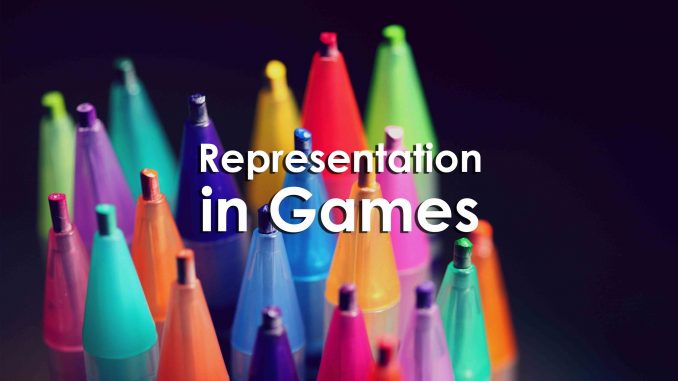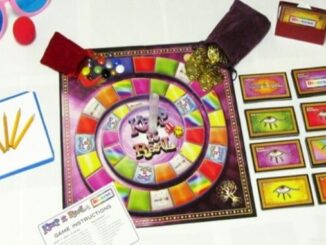
Games are mediums made for players. They are here for us to play and engage with them. Though, there have been some challenges in designing games that are representative. Not just representative of their designers; but more representative of the players as a whole.
Games need to address and take on the mantle of representing more than have they have historically. That’s because of a growing diversity of players, designers, academics, and industry leaders.
This article will address the historical overview of representation in games as well as how it reflects on the direction of the game industry. The article will review reasons to become more representative as well as some negative aspects that under-representation or misrepresentation has had in games.
The article will cover the growing diversity of gamers as well as some prime examples to follow. Representation is addressed as a concept of design accessibility and is followed with some action steps to take. Finally, representation as it relates to table top game play and future implications are included and discussed.
Historical overview
Maybe one of the most defining moments for gaming have been with its marketing strategy starting with video games in the 1980’s. With its heavy emphasis on young men; the industry relied mostly on that demographic to sell and market its wares.
That population grew to include a stereotypical type of gamer: white, male, single, and usually between the ages of 18-35.
This demographic also populated up into the industry though design. That means that other players and talented professionals such as young women and people of color saw themselves as underrepresented in this space. This often bled over into how they were portrayed (or not portrayed) in games.
However, we are presented with a new opportunity. That opportunity comes at the growth of independent game studios outside of major historical companies and the rise of crowd funding and independent designers. This wider representation in turn can appeal to these more diverse and wanting audiences.
Industry
Perhaps the initial lack of representation from diverse audiences in games was because of the lack of representation in the games industry. After all, designers tend to design what they know and what they like. So the lack of representation was initially a reflection of the industry.
However, a more open, diverse, and welcoming atmosphere is one that develop games that are more widespread and representative. These games are representative of types of gamers, rather than just appealing to a select few.
Part of that rise of representation is likely tied to the surge of the millennial buying trend with board games that emphasize strategy and cooperation over conflict and chance. This design change and direction is also representative of different accessibility principles. Now games have different goals as well as different ways to play games. Because of this, the field has become more open to new and different gamers. Thus, giving further rise to a demand in representation.
This is also reflected in video game, PC game, console, and mobile games which have become increasingly more diverse, inclusive, and representative. Of course this doesn’t mean that momentum towards this end should stop. But, this still represents significant progress and a movement towards a more representative medium.
Reasons to become more representative
Representation is often one of those ideas that most gamers can nod their heads to. However, it’s important to still ask the question: why should representation be an important aspect of games?
That’s because games as medium is one that is based on engagement by people and players. Games and inclusion is bigger than just one person. Historically, the game design field was not a very big or diverse place. Games designed by one particular demographic reflected this.
Though, this doesn’t have to be the case moving forward. The current player base can benefit by designing more inclusive and representative games. This is reflected by children who view all aspects of games as they play them. Seeing multiple players, characters, settings, and abilities represented can be empowering for young children.
Through this exposure; engagement; and activity; our youngest players internalize what it means to play games as well as “who” games are for. They are greater than just what our current players think they are for. They extend past that into empowering players to decide what they can become.
Representation doesn’t mean that we have to give up addressing and designing for player niches. Those will still remain and is something that designer should address throughout their process. However, like designing for player accessibility; representations helps us address and acknowledge more and different gamers in our field.
Though, this desire hasn’t come about without some acknowledgement of the negative aspects that have previously occurred due to a lack of representation.
Negative aspects
Misrepresentation and underrepresentation often don’t occur purposefully. Of course designers are going to concentrate on designing for what they know and what they want to see. It can be difficult to deprogram this seeming lifetime of cultural conditioning.
This is particularly evident in how gamers have treated female players in the past. Female players in video games have been the target of harassment as they are often one of the minority players on the platform.
This has lead to these female gamers adopting coping strategies such as gender masking, disguising their identities, or ultimately avoidance of gaming all together.
However, this isn’t limited to just digital games. Table top games have also had a history of lacking diversity and representation. This can be seen in player character as often being white and male.
We often don’t think about it; but the character types in some classic table top games like Guess Who? suffer from a lack of gender representation with five female characters versus nineteen men.
A more contemporary example is with the game Signore. The game has players playing the roles of noble families. In that role players are expected to find suitable partners for their daughters in an effort to expand increase their influence by marrying them off to other families.
Of course, some gamers demand that their games not become politicized or subject to political correctness. In actually, representation, diversity, and inclusion do not necessarily encompass either of those aspects. Really, representation is about addressing the widest possible audience by acknowledging that yes: people who are dissimilar from you are gamers as well.
This is often brought up in the argument that certain representations are more controversial than others. But that doesn’t necessarily need to be the case. In the example of Signore the role of women is accurate for the historical context; but the acknowledgement of using women as literally pawns in a game strikes me as distasteful. Just because a game includes a concept it doesn’t mean you have to like or approve of it.
Growing diversity
Despite these negative aspects; the growth and diversity of players is increasing. African Americans, Latinx, and Asian Americans are becoming increasingly more active in the gaming community. Likewise, these players of color are likely to play more than their white counterparts.
In addition, the US has seen has increase of female gamers with 45% of video gamers being women. That increase also includes mobile games. Close to half of all mobile game players are women and 65% of women aged 10-65 in the US play mobile games.
These increases and representation only highlight the lack of greater representation of these players. A more inclusive outlook that represents these growing populations is needed. The industry still needs to move forward. But, there have already been published games that have made significant contributions.
Examples to follow
There are some games that have become beacons to follow. When Fog of Love first arrived on the table top scene; both designers and players were cognizant of the diversity it could address in the community. Fog of Love is a game about a couple navigating a relationship. So, one of the earliest and most inclusive representations that it incorporated was different game covers featuring the different kinds of couples including same-sex ones.
This carries over to a more tried and true genre of table top gaming with One Deck Dungeon. The fantasy world of games there tends to be wrought with typical representation of males and lack of diversity of women and people of color. Though designer, Chris Cieslik made a conscious choice to include women and minorities. Additionally, the designer also included those characters in different body types and shapes as well. Pandemic by Matt Leacock follows suit with playable characters being women and people of color.
Lastly, in Dead of Winter, players have the choice to play the character Hugo Valentine as an androgynous bike messenger whose gender is only revealed later through some character interactions and reveals.
Action steps for representation in design
This representation can and often does start with designers. But it doesn’t have to be. Yes, game designers are at the forefront of what they can include and should include in a game. But there stands reason to still design and create for a specific audience. So a common criticism is that if a game doesn’t reflect the individual player – then it isn’t for them.
That doesn’t have to be the case for all games. We can all play and consume them in order to role play as someone else. Instead, representation seeks to include as many as possible from the beginning; rather than to think of player acceptance and representation as an afterthought. The effort for representation is appreciated – no matter how small.
This is most often seen in the cover art of games as they are the first (and sometimes the last) thing that a player sees before making a purchase. This is something that can be addressed by including characters of diverse and represented backgrounds in order to provide players with something (or someone) to relate to in the game.
From the cover, designers can provide other avenues of representation by including both male and female versions of player boards for players to choose from.
This inclusion of gender diversity doesn’t have to be difficult as it pertains to rule books. One of the easiest ways to do that is to be inclusive of different names as well as using gender neutral terms in specific play examples like: “Alex uses their turn to claim one wood.”
Designers can also include different gender expressions, queer relationships, and other components of non-player characters as part of the game’s story. This can provide other relevant socio-cultural hooks for players to connect and identify with the game.
Table top connection
Table top games are specifically poised to include more representation for its players. That’s because table top games are activities that are meant to be played socially with other players. It’s a medium about connecting one person to the other.
That means that table top games can be a way to play as well as a way to bring people of different backgrounds together. That can sometimes be over competition; but it also be about inclusion; teamwork; and lateral thinking.
Future implications
A lack of diversity and representation in games can be a missed sales opportunity. But, by creating and catering to just one demographic we will completely miss the opportunity to serve a much wider one.
While women and people have color have become more engaged with gaming culture; we as group still need to become more proactive and inclusive in our design approach and how it affects players. Gamers are no longer just for the stereotypical type of gamer: white, male, single, and usually between the ages of 18-35.
This is especially true for table top games. As millennials represent a significant part of the table top market; perceptions and trends of who a “gamer” is will continue to evolve and change.
Takeaways
This article addressed the historical overview of representation in games as well as how it reflects on the direction of the game industry. The article reviewed reasons to become more representative as well as some negative aspects that under-representation or misrepresentation can have in games. The article covered the growing diversity of gamers as well as some prime examples to follow. Representation was addressed as a concept of design accessibility and was followed with some action steps to take. Finally, representation as it relates to table top game play and future implications were included and discussed.
This article was originally published by Dave in his blog Representation in Games
This article was about representation in games. To learn more about representation in gamification, check out the free course on Gamification Explained.
If you have enjoyed this article – consider getting yourself lifetime access to his Games-Based Learning Digital Library containing all of the content from the past two Games-Based Learning Virtual Conferences; past webinars and courses he’s created; as well as his complete back catalog of articles; podcast episodes; and videos. And more content is being added all the time.
Readers of Ludogogy can get a $50 discount on this valuable resource by using this link.
References and further reading:
Diversity and Inclusivity in Board Game Design. (2020, March 6). Retrieved March 13, 2020, from https://www.boardgames.ca/blogs/blog/diversity-and-inclusivity-in-board-game-design/
Eng, D. (2020, March 12). Accessibility in Games. Retrieved March 18, 2020, from https://www.universityxp.com/blog/2020/3/12/accessibility-in-games
Packwood, D. (2018, October 31). The era of white male games for white male gamers is ending. Retrieved March 13, 2020, from https://qz.com/1433085/the-era-of-white-male-games-for-white-male-gamers-is-ending/
Pobuda, T. (2018, December 2). Assessing Gender and Racial Representation in the Board Game Industry. Retrieved March 13, 2020, from http://analoggamestudies.org/2018/12/assessing-gender-and-racial-representation-in-top-rated-boardgamegeek-games/
Ramanan, C. (2017, March 15). The video game industry has a diversity problem – but it can be fixed. Retrieved March 13, 2020, from https://www.theguardian.com/technology/2017/mar/15/video-game-industry-diversity-problem-women-non-white-people
Ruhlman, R. (2018, March 14). Transgender Representation in Board Games. Retrieved March 13, 2020, from https://storyboardgamer.com/2018/03/14/transgender-representation/
Sadin, C. (2017, February 2). Board Games With Great Representation and Diversity. Retrieved March 13, 2020, from https://dtgreviews.com/roundups/board-games-with-representation/
Scott, P. (2018, July 5). Board Games Are Growing In Popularity And Diversity, Thanks To Millennials. Retrieved March 13, 2020, from https://www.wbur.org/artery/2018/07/05/board-games-diversity-millennials
Why Diversity In Board Games Matters. (2019, April 20). Retrieved March 13, 2020, from https://kidsloveboardgames.com/family-board-game-tips/why-diversity-in-board-games-matters/
Wong, C. (2019, April 13). Inclusion and Diversity in Board Gaming: An FAQ in comic form. Retrieved March 13, 2020, from https://storyboardgamer.com/2018/04/13/inclusion-and-diversity-in-board-gaming-an-faq-in-comic-form/
- How do you Design Games for Flow State - 26th January 2024
- Accessibility in Games - 22nd November 2023
- What are Megagames? - 5th September 2023





Thought-provoking; thank you.
With reference to the ‘anti-PC’ worries you mention, I think recent events have shown us that loud anti-representation voices often create the impression that they are more numerous and/or important than in fact they are, just by shouting so loudly. The backlash against the gender-switching of Ghostbusters and Doctor Who are relevant here, even if not about boardgames, as is Gamergate and (again in a different sphere but with some similar audiences) the Sad Puppy debacle in fiction fandom.
I wonder if there are some creators out there who see such controversies and shy away from necessary and also profitable representation because they overestimate the power and spending power of such lobbies. But in films, fiction and games (and in most of the above specific examples), progress and profitability in increasing representation has continued despite the efforts of those against it.
Learning games may have a head start in getting past that, as they’re probably less heavily tied to a space in which a privileged traditional consumer base sees change as a threat.
I agree Terry. Unfortunately, being loudest seems to be a very effective strategy to silence others. Even those who would normally stand up and be counted quite happily find it too draining to be harangued – even if it only by one or two very strident voices.
I think you are also right that learning games have a head start, partially because we are often being asked to create learning experiences in these very areas around diversity, inclusion and so on – games being seen as a good way to deal with potentially ‘difficult’ issues. I think the biggest risk we face in these areas is being asked and expected to, meet statutory requirements for training quickly and cheaply – ‘can you do me some e-learning that will ‘do’ D&I for our staff in under 45 mins, please?’ when what we actually want to do is create meaningful experiences that will effect real, lasting change.